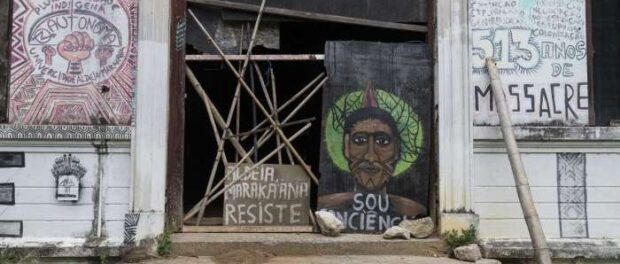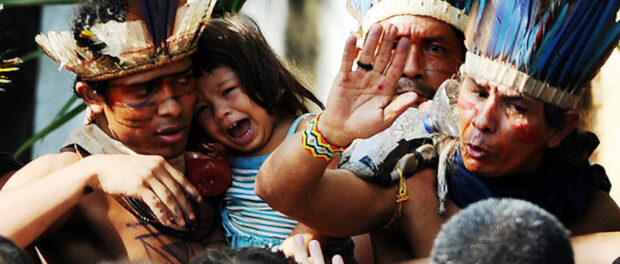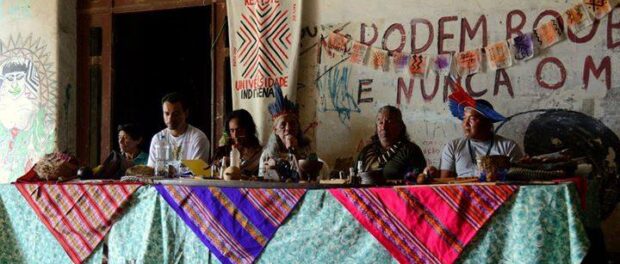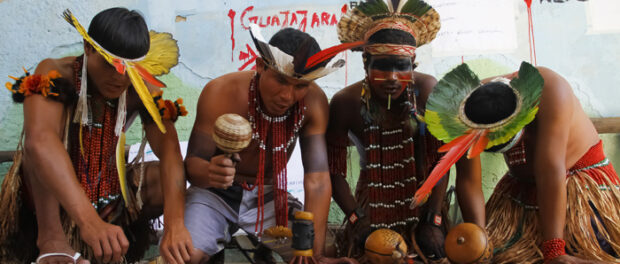
On January 4, O Globo reported on the assertion by state representative Rodrigo Amorim (of the far-right Brazilian Social Liberal Party–PSL) that Aldeia Maracanã—an urban indigenous community (aldeia means “village”) in Rio de Janeiro—is “urban garbage.” Amorim, one of the two men that broke the street sign in memory of late city councilor Marielle Franco prior to October’s elections (and was subsequently elected state deputy with 140,000 votes), described Aldeia Maracanã today as a “crack land” in need of a “cleaning” to “restore order,” stating that there were no indigenous persons there, but only “migrants with no relations to Indians.” Echoing the same logic and plans as former governor Sérgio Cabral during the group’s eviction from the grounds of the abandoned Indigenous Museum in Rio’s North Zone in 2012-2013, Amorim defended that the area could serve as a shopping mall, parking lot, leisure area or as part of the neighboring Maracanã Stadium. He added that “those who like Indians should go to Bolivia, which is not only a communist country but is also governed by an Indian.”
To anyone familiar with the history and struggle of Aldeia Maracanã, Amorim’s affirmations are evidently misinformed. They also echo the prejudice and discrimination that president-elect Jair Bolsonaro and his allies have been expressing in regards to indigenous peoples in Brazil. In response to this discrimination, a group composed of members of Aldeia Maracanã is considering suing Amorim, according to co-president of Rio’s State Council for Indigenous Rights, Carlos Doethyró Tukano. President of the Aldeia Maracanã Indigenous Association Marize Guarani called for more action from left wing parties, unions, and social movements in Rio and across Brazil in the face of such attacks from the new government, stating: “The unions and left wing parties have all been too quiet, but we will not be quiet. The Acampamento Terra Livre (“Free Land Camp”—a national indigenous meeting held in Brasília every year) has to be the biggest one yet this year.”
To counter further confusion about Aldeia Maracanã and join in combating such discrimination, this article provides a brief history and overview of the movement, which is now made up of two groups: the Aldeia Maracanã Indigenous Association (AIAM) and Aldeia Rexiste (“The Village Re-Exists/Resists”). Of the two, only the latter continues to occupy the abandoned building.
Reclaiming the Abandoned Indigenous Museum: 2006-2012
The story of Aldeia Maracanã began in 2006 when the Tamoio Original Peoples Movement, an indigenous collective, gathered at the Rio de Janeiro State University (UERJ) for the 1st Original Peoples Seminar. From there, they decided to cross the street and reclaim the abandoned building of the Indigenous Museum, which the National Indian Foundation (FUNAI) relocated to the Botafogo neighborhood in Rio’s South Zone in the 1970s.

Why was the building important? Firstly, because of its long history as a site tied to conservation of indigenous culture in the heart of Rio de Janeiro, starting in 1953 when it became the Indigenous Museum, but potentially even before that. To this day, it represents one of few sites dedicated to indigenous peoples in the city. As a result of Brazil’s long history of assimilationist policy that gave the government the power to define which groups count as indigenous and due to the stereotyped way that school curricula portray indigenous peoples, those in an urban context have historically been rendered invisible for not fitting with state-approved or stereotyped images of indigenous peoples—i.e., rural communities that look radically different and have radically different cultures and lifestyles (for example, where cell phones or the Internet are not used). Secondly, the site offered a space in which to centralize and thereby facilitate the movement’s activities. Finally, its location right by the Maracanã Stadium was strategic, affording the group a greater level of visibility. As such, the site could function as an “indigenous embassy”: indigenous people passing through the city and needing a place to stay or wanting to meet fellow indigenous people in Rio would know where to turn and avoid ending up in the city’s peripheries, as is often the case.
From 2006 to 2013, the group turned the grounds of the abandoned museum into a collective housing project—a community from which to organize cultural, political, and spiritual activities. Members built individual and collective houses; took care of the garden and trees; erected an indigenous-style oca for holding rituals; and held monthly storytelling events, workshops, fairs, and exhibitions. They named their community Aldeia Maracanã because, for them, the community was an aldeia—a village. By forming this community, their aim was always to further the struggles of indigenous peoples around Brazil and debunk the misperception that indigenous people do not “belong” in the city, for indigenous peoples have lived in and passed through cities throughout history.
The circa 35 persons who made up Aldeia Maracanã—belonging to 17 different ethnic groups—were no exception to this. Many had migrated to Rio to look for work, sell handcrafted goods, receive health care, or study. Others had been born in the city of Rio but had retained strong connections to their indigenous communities. Still others were only just reconnecting with their communities, often because Aldeia Maracanã offered a location in which to meet, learn about, and look for their parentes (“relatives,” as indigenous people often call one another in Brazil). It was in this way that Aldeia Maracanã became the site of a Puri resurgence movement, for example. The descendants of the Puri, declared officially extinct, have been collectively working towards reconnecting with their ancestry in a process called “ethnogenesis.” Indigenous people do not “disappear” or “cease to be indigenous” when they come to the city—quite the opposite, they can often revive and re-invent their identities and political movements in the urban context.
Resisting Removal: 2012-2013
Until the preparations for the 2014 FIFA World Cup and 2016 Olympic Games began, the community received little attention. When the Maracanã region became of speculative interest to the upcoming sports mega-events, Rio’s government carried out several evictions and removals around the neighborhood and Aldeia Maracanã came under attack. In 2012, Sérgio Cabral, Rio’s governor at the time and now serving life in jail, planned to turn the site into a parking lot for the Maracanã Stadium and later an Olympic Museum, much in consonance with Amorim’s recent statement.
After receiving their eviction notice, Aldeia Maracanã began to mobilize, looking for support from state and federal agencies as well as non-governmental organizations. In the absence of sustained support, including from FUNAI, they turned to social media and collective organizing. As 2013 progressed, they suffered several attempts at removal and became part of the growing dissatisfaction with the preparations for the sports mega-events that culminated in the June 2013 protests.
As tensions rose and the government’s approval rates dropped, Rio’s former Secretary of Culture Adriana Rattes saw an opportunity in Aldeia Maracanã and contacted the group to discuss an agreement. She was unable to reverse the eviction notice since it was already official but offered the possibility of registering the building as a site of historical significance (thus impeding its demolition) and initiating a partnership to redevelop the building if the group could come up with a reasonable proposal.

It was at this point that the group split. As is often the case in social movements pressured into cooperating with the government, some group members wanted to reach an agreement to save the building and save at least part of their community and project. Others believed that the site should remain under exclusive indigenous management, that it should become an Indigenous University, and that any agreements with the government would co-opt their political project. Several internal and external meetings followed.
Two Movements: Aldeia Rexiste and the Indigenous Association Aldeia Maracanã
In the end, one part of the group reached an agreement with the state government to register the building as a heritage site and turn it into the Reference Center for Indigenous Cultures. They agreed to relocate to provisional housing in Jacarepaguá, in Rio’s West Zone, and, later, to a Minha Casa Minha Vida public housing condominium in Estácio, in Central Rio. To co-manage the future Reference Center, they created the Aldeia Maracanã Indigenous Center and the State Council for Indigenous Rights. The building’s renovation has stagnated under post-mega-events austerity, but the group continues to push for it.
The other group—which re-named itself Aldeia Rexiste—refused to leave the abandoned building. The group’s members were violently evicted in March 2013 but continued trying to re-occupy the building thereafter.

These two movements now battle separate but related fronts in the struggle for Aldeia Maracanã: they are united in the aim to protect indigenous rights and transform the reality of indigenous peoples in urban centers but believe in distinct paths to that end. Remembering the meeting that Aldeia Maracanã organized at the Hotel Novo Mundo to discuss the future of the building in December 2013, which several major national indigenous leaders including Ancieto Xavante and Marcos Terena and almost 90 different ethnic groups attended, Marize Guarani stressed:
Aldeia Maracanã is not an institution that is either of the AIAM or of Aldeia Rexiste, it is a national institution that should serve as a meeting point and point of discussion for all indigenous peoples around the world. The attacks that indigenous people suffer in Brazil, such as the one by Amorim, are experienced by indigenous peoples worldwide.
When Amorim spoke about Aldeia Maracanã, he showed no awareness of this history or the political articulation that has been taking place both through institutionalized channels via the AIAM and the State Council, or through direct action by Aldeia Rexiste’s re-occupation of the building. Moreover, Amorim shows no awareness that the abandoned museum has been registered as a heritage site and that the government has already reached an agreement with Aldeia Maracanã, promising that the building will be renovated and dedicated to the purposes of indigenous peoples. To say that “there are no indigenous people there” is a lazy attack on Aldeia Rexiste’s authenticity as an indigenous collective that does not withstand scrutiny.
Far from being “urban garbage,” Aldeia Maracanã is a living movement—a community that has outlived its eviction from their territory (the site of the abandoned building). Aldeia Maracanã is evidence that, no matter how many times indigenous peoples are dispossessed, discriminated against, silenced, and invisibilized, they will find the space for resistance, survival, and resurgence. And that space will also be in the city.


